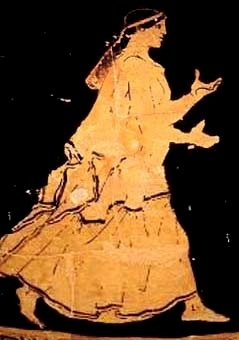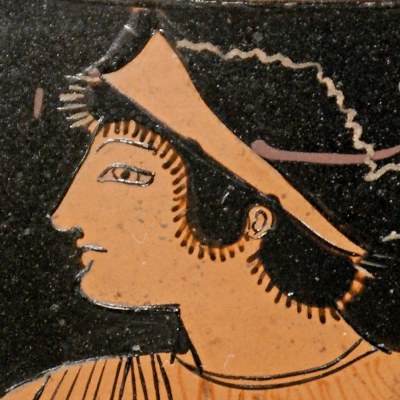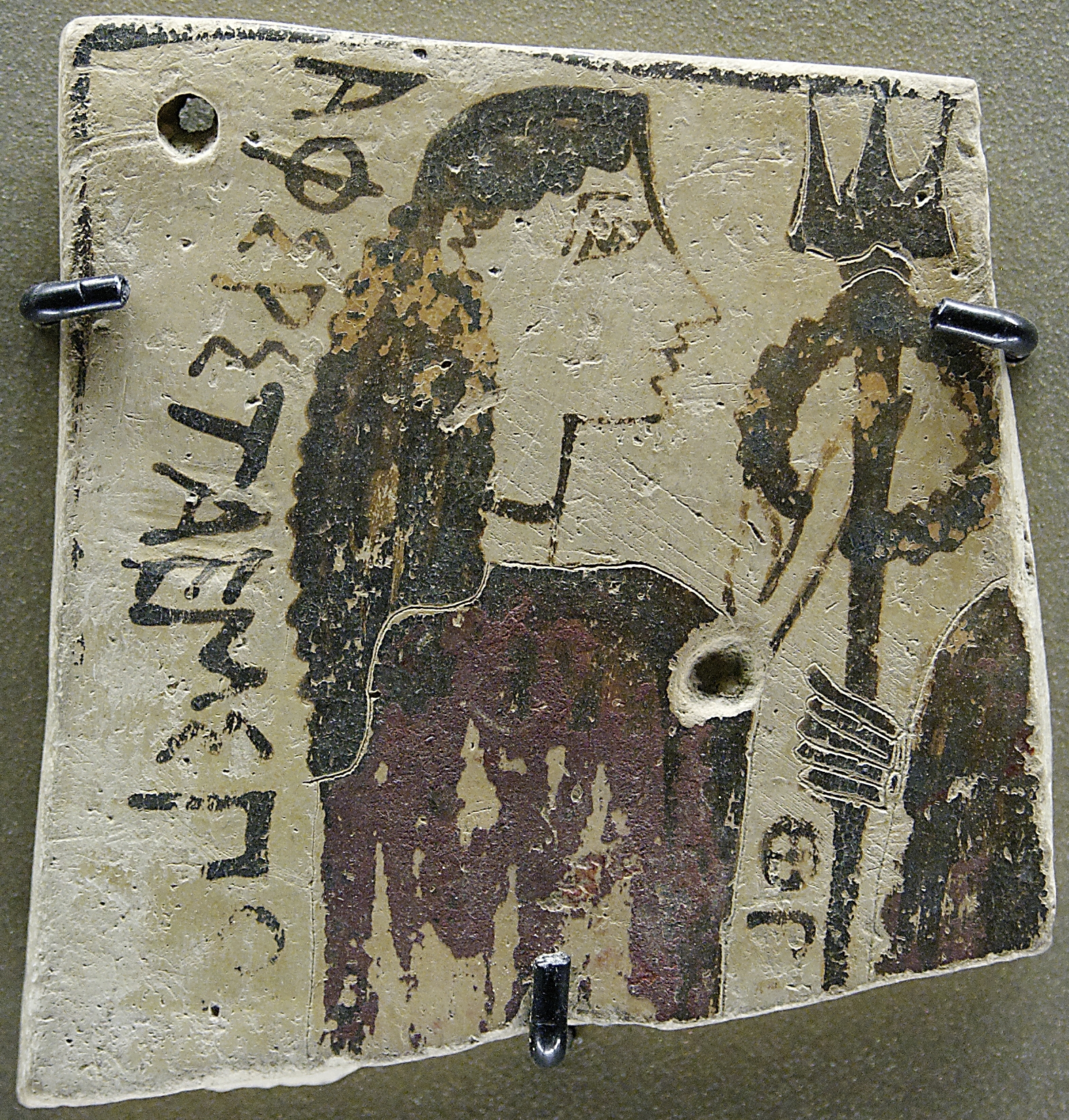|
Nereid
In Greek mythology, the Nereids or Nereides ( ; grc, Νηρηΐδες, Nērēḯdes; , also Νημερτές) are sea nymphs (female spirits of sea waters), the 50 daughters of the 'Old Man of the Sea' Nereus and the Oceanids, Oceanid Doris (mythology), Doris, sisters to their brother Nerites (mythology), Nerites. They often accompany Poseidon, the god of the sea, and can be friendly and helpful to sailors (such as the Argonauts in their search for the Golden Fleece). Etymology The synonyms Νηρηΐδες and Νημερτές are etymologically unrelated. Νηρηΐδες is a patronymic, describing them as the daughters of Nereus. Νημερτές means literally 'not-mistaking', and there is an adjective of the same form meaning 'clear', 'unmistakable', or 'true'. Mythology The Nereids symbolized everything that is beautiful and kind about the sea. Their melodious voices sang as they danced around their father. They are represented as beautiful women, crowned with branc ... [...More Info...] [...Related Items...] OR: [Wikipedia] [Google] [Baidu] |
Nereid Pompeii Fresco
In Greek mythology, the Nereids or Nereides ( ; grc, Νηρηΐδες, Nērēḯdes; , also Νημερτές) are sea nymphs (female spirits of sea waters), the 50 daughters of the 'Old Man of the Sea' Nereus and the Oceanid Doris, sisters to their brother Nerites. They often accompany Poseidon, the god of the sea, and can be friendly and helpful to sailors (such as the Argonauts in their search for the Golden Fleece). Etymology The synonyms Νηρηΐδες and Νημερτές are etymologically unrelated. Νηρηΐδες is a patronymic, describing them as the daughters of Nereus. Νημερτές means literally 'not-mistaking', and there is an adjective of the same form meaning 'clear', 'unmistakable', or 'true'. Mythology The Nereids symbolized everything that is beautiful and kind about the sea. Their melodious voices sang as they danced around their father. They are represented as beautiful women, crowned with branches of red coral and dressed in white silk robes ... [...More Info...] [...Related Items...] OR: [Wikipedia] [Google] [Baidu] |
Psamathe (Nereid)
In Greek mythology, Psamathe ( grc, Ψαμάθη) is a Nereid, one of the fifty daughters of the sea god Nereus and the Oceanid Doris. By Aeacus, the king of Aegina, she is the mother of a son, Phocus. When Phocus is killed by his half-brothers Peleus and Telamon, Psamathe sends a giant wolf at Peleus' herd. Family Psamathe is one of the fifty Nereids, daughters of Nereus and Doris. By Aeacus, the king of Aegina, she is the mother of a son, Phocus. She is later the wife of Proteus, king of Egypt, by whom she has a son, Theoclymenos, and a daughter, Eido (later known as Theonoe). Mythology There are two myths which involve Psamathe. The first is the story of her violation by Aeacus. Upon his advances, she transforms herself into a seal in an attempt to escape. She is unsuccessful, however, and from their union is born Phocus, whose name (''phoke'' meaning "seal") recalls his mother's metamorphosis. Peleus and Telamon are the sons of Aeacus by his wife Endeis. The two of ... [...More Info...] [...Related Items...] OR: [Wikipedia] [Google] [Baidu] |
Thetis
Thetis (; grc-gre, Θέτις ), is a figure from Greek mythology with varying mythological roles. She mainly appears as a sea nymph, a goddess of water, or one of the 50 Nereids, daughters of the ancient sea god Nereus. When described as a Nereid in Classical myths, Thetis was the daughter of Nereus and Doris, and a granddaughter of Tethys with whom she sometimes shares characteristics. Often she seems to lead the Nereids as they attend to her tasks. Sometimes she also is identified with Metis. Some sources argue that she was one of the earliest of deities worshipped in Archaic Greece, the oral traditions and records of which are lost. Only one written record, a fragment, exists attesting to her worship and an early Alcman hymn exists that identifies Thetis as the creator of the universe. Worship of Thetis as the goddess is documented to have persisted in some regions by historical writers such as Pausanias. In the Trojan War cycle of myth, the wedding of Thetis and th ... [...More Info...] [...Related Items...] OR: [Wikipedia] [Google] [Baidu] |
Amphitrite
In ancient Greek mythology, Amphitrite (; grc-gre, Ἀμφιτρίτη, Amphitrítē) was the goddess of the sea, the queen of the sea, and the wife of Poseidon. She was a daughter of Nereus and Doris (or Oceanus and Tethys).Roman, L., & Roman, M. (2010). Under the influence of the Olympian pantheon, she became the consort of Poseidon and was later used as a symbolic representation of the sea. Her Roman counterpart is Salacia, a comparatively minor figure, and the goddess of saltwater. Mythology Amphitrite was a daughter of Nereus and Doris (and thus a Nereid), according to Hesiod's ''Theogony'', but of Oceanus and Tethys (and thus an Oceanid), according to the '' Bibliotheca'', which actually lists her among both the Nereids and the Oceanids. Others called her the personification of the sea itself (saltwater). Marriage to Poseidon When Poseidon desired to marry her, Amphitrite, wanting to protect "her virginity", fled to the Atlas mountains. Poseidon sent many crea ... [...More Info...] [...Related Items...] OR: [Wikipedia] [Google] [Baidu] |
Nereus
In Greek mythology, Nereus ( ; ) was the eldest son of Pontus (the Sea) and Gaia (the Earth), with Pontus himself being a son of Gaia. Nereus and Doris became the parents of 50 daughters (the Nereids) and a son ( Nerites), with whom Nereus lived in the Aegean Sea. Etymology R. S. P. Beekes suggests a Pre-Greek origin. Mythology In the ''Iliad'', the Old Man of the Sea is the father of Nereids, though Nereus is not directly named. He was never more manifestly the Old Man of the Sea than when he was described, like Proteus, as a shapeshifter with the power of prophecy, who would aid heroes such as Heracles who managed to catch him even as he changed shapes. Nereus and Proteus (the "first") seem to be two manifestations of the god of the sea who was supplanted by Poseidon when Zeus overthrew Cronus. The earliest poet to link Nereus with the labours of Heracles was Pherekydes, according to a ''scholion'' on Apollonius of Rhodes. During the course of the 5th century BC, Ne ... [...More Info...] [...Related Items...] OR: [Wikipedia] [Google] [Baidu] |
Achilles
In Greek mythology, Achilles ( ) or Achilleus ( grc-gre, Ἀχιλλεύς) was a hero of the Trojan War, the greatest of all the Greek warriors, and the central character of Homer's ''Iliad''. He was the son of the Nereid Thetis and Peleus, king of Phthia. Achilles' most notable feat during the Trojan War was the slaying of the Trojan prince Hector outside the gates of Troy. Although the death of Achilles is not presented in the ''Iliad'', other sources concur that he was killed near the end of the Trojan War by Paris, who shot him with an arrow. Later legends (beginning with Statius' unfinished epic ''Achilleid'', written in the 1st century AD) state that Achilles was invulnerable in all of his body except for one heel, because when his mother Thetis dipped him in the river Styx as an infant, she held him by one of his heels. Alluding to these legends, the term " Achilles' heel" has come to mean a point of weakness, especially in someone or something with an otherwise strong ... [...More Info...] [...Related Items...] OR: [Wikipedia] [Google] [Baidu] |
Triton (mythology)
Triton (; grc-gre, Τρίτων, Trítōn) is a Greek mythology, Greek god of the sea, the son of Poseidon and Amphitrite, god and goddess of the sea respectively. Triton lived with his parents in a golden palace on the bottom of the sea. Later he is often depicted as having a conch shell he would blow like a trumpet. Triton is usually represented as a merman, with the upper body of a human and the tailed lower body of a fish. At some time during the Greek and Roman era, Triton(s) became a generic term for a merman (mermen) in art and literature. In English literature, Triton is portrayed as the messenger or herald for the god Poseidon. Triton of Lake Tritonis of ancient Libya is a namesake mythical figure that appeared and aided the Argonauts. Moreover, according to Apollonius Rhodius, he married the Oceanids, Oceanid of said region, Libya (Greek myth), Libya. Sea god Triton was the son of Poseidon and Amphitrite according to Hesiod's ''Theogony''. He was the ruler (possesso ... [...More Info...] [...Related Items...] OR: [Wikipedia] [Google] [Baidu] |
Oceanids
In Greek mythology, the Oceanids or Oceanides (; grc, Ὠκεανίδες, Ōkeanídes, pl. of grc, Ὠκεανίς, Ōkeanís, label=none) are the nymphs who were the three thousand (a number interpreted as meaning "innumerable") daughters of the Titans Oceanus and Tethys. Description and function The Oceanids' father Oceanus was the great primordial world-encircling river, their mother Tethys was a sea goddess, and their brothers the Potamoi (also three thousand in number) were the personifications of the great rivers of the world. Like the rest of their family, the Oceanid nymphs were associated with water, as the personification of springs. Hesiod says they are "dispersed far and wide" and everywhere "serve the earth and the deep waters", while in Apollonius of Rhodes' ''Argonautica'', the Argonauts, stranded in the desert of Libya, beg the "nymphs, sacred of the race of Oceanus" to show them "some spring of water from the rock or some sacred flow gushing from the earth ... [...More Info...] [...Related Items...] OR: [Wikipedia] [Google] [Baidu] |
Phocus Of Aegina
In Greek mythology, Phocus (; Ancient Greek: Φῶκος means "seal"), was a prince of Aegina and son of Aeacus and Psamathe. Mythology Phocus' mother Psamathe, the Nereid goddess of sand beaches, transformed herself into a seal when she was ambushed by Aeacus, and was raped as a seal; conceived in the rape, Phocus' name means "seal".Apollodorus, 3.12.6 According to Pindar, Psamathe gave birth to Phocus on the seashore. By Asteria or Asterodia, Phocus had twin sons, Crisus and Panopeus. Aeacus favored Phocus over Peleus and Telamon, his two sons with Endeïs. The '' Bibliotheca'' characterizes Phocus as a strong athlete, whose athletic ability caused his half-brothers to grow jealous. Their jealousy drove them to murder him during sport practice; Telamon, the stronger half-brother, threw a discus at Phocus' head, killing him. The brothers hid the corpse in a thicket, but Aeacus discovered the body and punished Peleus and Telamon by exiling them from Aegina. Telamon was sent t ... [...More Info...] [...Related Items...] OR: [Wikipedia] [Google] [Baidu] |
Nymph
A nymph ( grc, νύμφη, nýmphē, el, script=Latn, nímfi, label=Modern Greek; , ) in ancient Greek folklore is a minor female nature deity. Different from Greek goddesses, nymphs are generally regarded as personifications of nature, are typically tied to a specific place or landform, and are usually depicted as maidens. They were not necessarily immortal, but lived much longer than human beings. They are often divided into various broad subgroups, such as the Meliae (ash tree nymphs), the Dryads (oak tree nymphs), the Naiads (freshwater nymphs), the Nereids (sea nymphs), and the Oreads (mountain nymphs). Nymphs are often featured in classic works of art, literature, mythology, and fiction. Since the Middle Ages, nymphs have been sometimes popularly associated or even confused with fairies. Etymology The Greek word has the primary meaning of "young woman; bride, young wife" but is not usually associated with deities in particular. Yet the etymology of the noun remains ... [...More Info...] [...Related Items...] OR: [Wikipedia] [Google] [Baidu] |
Proteus
In Greek mythology, Proteus (; Ancient Greek: Πρωτεύς, ''Prōteus'') is an early prophetic sea-god or god of rivers and oceanic bodies of water, one of several deities whom Homer calls the "Old Man of the Sea" ''(hálios gérôn)''. Some who ascribe a specific domain to Proteus call him the god of "elusive sea change", which suggests the constantly changing nature of the sea or the liquid quality of water. He can foretell the future, but, in a mytheme familiar to several cultures, will change his shape to avoid doing so; he answers only to those who are capable of capturing him. From this feature of Proteus comes the adjective protean, meaning "versatile", "mutable", or "capable of assuming many forms". "Protean" has positive connotations of flexibility, versatility and adaptability. Name origin Proteus' name suggests the "first" (from Greek "πρῶτος" ''prōtos'', "first"), as ''prōtogonos'' (πρωτόγονος) is the "primordial" or the "firstborn". It is ... [...More Info...] [...Related Items...] OR: [Wikipedia] [Google] [Baidu] |
Polyphemus
Polyphemus (; grc-gre, Πολύφημος, Polyphēmos, ; la, Polyphēmus ) is the one-eyed giant son of Poseidon and Thoosa in Greek mythology, one of the Cyclopes described in Homer's ''Odyssey''. His name means "abounding in songs and legends". Polyphemus first appeared as a savage man-eating giant in the ninth book of the ''Odyssey''. The satyr play of Euripides is dependent on this episode apart from one detail; Polyphemus is made a pederast in the play. Later Classical writers presented him in their poems as heterosexual and linked his name with the nymph Galatea. Often he was portrayed as unsuccessful in these, and as unaware of his disproportionate size and musical failings. In the work of even later authors, however, he is presented as both a successful lover and skilled musician. From the Renaissance on, art and literature reflect all of these interpretations of the giant. Odysseus and Polyphemus Ancient sources In Homer's epic, Odysseus lands on the island of the ... [...More Info...] [...Related Items...] OR: [Wikipedia] [Google] [Baidu] |










